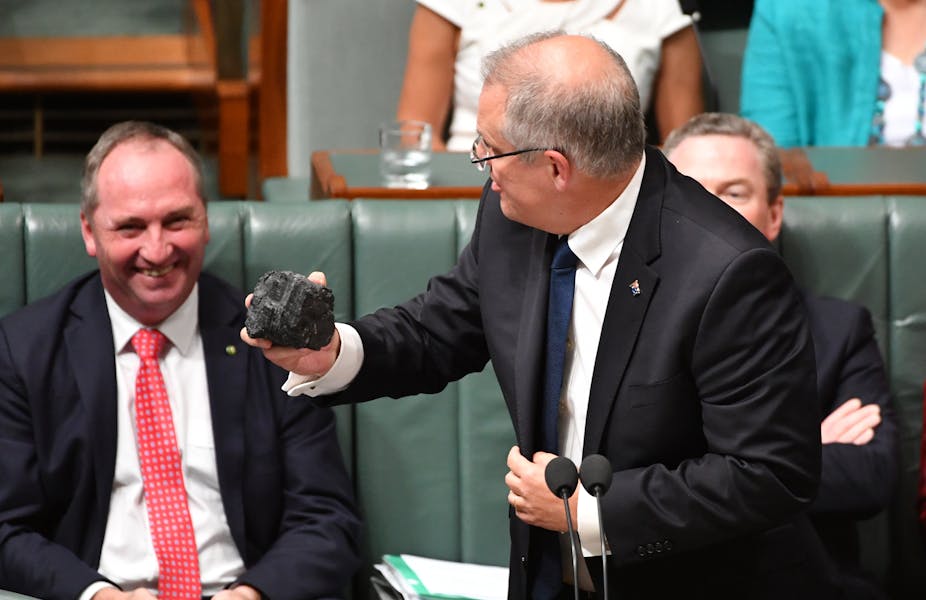This summer has seen a concerted attack on renewable energy coming out of Canberra, featuring everyone from One Nation senator Malcolm Roberts to Coalition ministers channelling the far right of their party. So absurd and illogical has the broadside been, it is tempting to conclude that conservative politics is at risk of losing its way entirely.
In 2017, talking down renewables while advocating “clean coal” smacks of desperation and political recklessness in the face of the wider forces that are now lighting up the path to a renewable future.
Here are my picks for the top four most absurd attempts at gaming the politics of energy from right-of-centre politicians.
1. The poll that backfired
In the top spot is Malcolm Roberts – former coal executive, current senator and full-time climate denier – who held a poll on Twitter to see how much voters hate “green energy”.

The only problem was that his poll (as unscientific as these things are), ended up showing overwhelming support for renewables, at 87%.
Of course the premise in his question is disingenuous, as the Coalition government has recently attempted to divert some of the money originally set aside for renewables into some decidedly non-renewable projects. Which brings us to…
2. ‘Clean’ coal
Funding “clean coal” – a term invented by a coal industry PR firm, would be a spectacularly brazen repurposing of green energy funding. It hinges on the idea that techniques like carbon capture and storage can help coal become clean enough to compete with zero-carbon energy sources like wind and solar. Under this perverse reasoning, coal would thus qualify for subsidies from the very funding bodies that were set up to end our reliance on coal.
The campaign, which kicked off with Prime Minister Malcolm Turnbull’s National Press Club Speech on Feb 1, reached its apex when Treasurer Scott Morrison brandished a lump of coal in parliament. But as Lenore Taylor pointed out last week, the argument for clean coal, which the Minerals Council of Australia (MCA) has been pushing for many years, has the government looking like the adman.
3. Attacks on ‘ideology’
While pushing clean coal at the behest of the fossil fuel industry, the Coalition has ironically also been warning us of Labor’s “ideological” campaign for renewable energy.
In a scalding attack last week, business analyst Alan Kohler accused the government of being “evangelists” for coal, and wondered what has happened to the Malcolm Turnbull who once sacrificed his leadership to his progressive personal convictions on climate. He wrote:
…one suspects that Morrison and Turnbull know too – we all know, really – that the only reason coal is “cheap” is that the cost of dealing with the carbon dioxide that comes from burning it is not included in the price.
Coal is by far the most expensive fuel for generating electricity, full stop — if the cost of dealing with climate change is taken into account.
The MCA and the Turnbull government are among the few groups still resisting the inevitable.

4. Using the weather as a weapon
Despite the Coalition looking increasingly isolated on energy policy, the rearguard action against renewables continues. For weeks now we have been hearing about the need for an energy mix that is secure, reliable and affordable, as energy minister Josh Frydenberg told us on ABC radio on Monday.
This platform of energy security has been used to launch a disingenuous attack on renewables, based on their alleged unreliability (which is allegedly even worse during climate-induced bouts of extreme weather).
The first such attack came in the wake of the cyclone in South Australia that triggered a statewide blackout last September. South Australia’s wind energy industry was again singled out for criticism after a heatwave prompted more outages this month.
Turnbull took the opportunity to draw a link between the blackouts and SA’s high penetration of renewable energy:
If you want to have a larger and larger share of intermittent renewables in your energy system then you need to have the backup … when the wind isn’t blowing.
The day after the blackout (and with the heatwave bearing down on Sydney), Morrison held up his coal in parliament and pledged not to let business “fizzle out in the dark” as he claimed Labor would.
However, a week later the Australian Energy Market Operator (AEMO) apologised to the 90,000 households and businesses affected by the blackouts, attributing them to load-shedding and pointing out that a software error cut off 60,000 extra consumers unnecessarily. AEMO added that because heatwaves have grown more extreme under the warming climate, it was unable to forecast accurately how much extra supply would be needed.
The anti-renewables message finally came unstuck last weekend, when it was revealed that Turnbull and his ministers had already been advised that renewables were not to blame for last September’s incident.
Meanwhile, as the heatwave moved across New South Wales, there is evidence that renewables such as rooftop solar dramatically reduced the need for load-shedding.
But one of the biggest ironies of the Coalition’s decision to pick on SA’s wind farms is that many of them were put there by federal government policy.
As Ben Eltham wrote last week:
After eight years of treating energy policy as a plaything for political gain, the federal Liberal Party is now so wedded to climate denialism and fossil fuel loyalty signalling that it knows no other way. In the process, Malcolm Turnbull has abandoned nearly everything he once stood for … except perhaps the only real thing he ever stood for, the gaining and holding of power.
In attempting to distance the Commonwealth from projects that are actually making progress on climate, Turnbull has executed a complete reversal of his own personal convictions on climate change. Perhaps party-political expedience really is the only explanation for the ongoing war of words on renewable energy.

